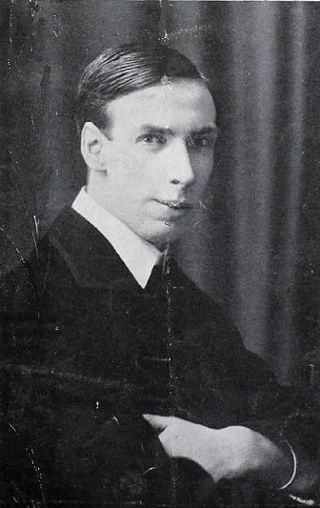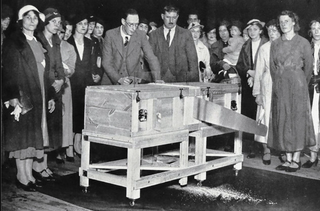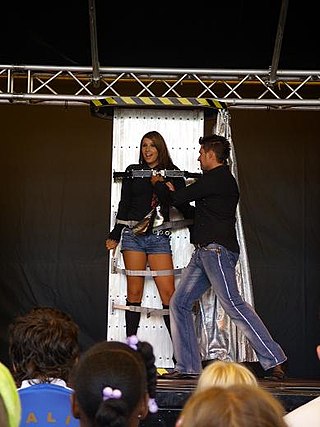
David Seth Kotkin, known professionally as David Copperfield, is an American magician, described by Forbes as the most commercially successful magician in history.

The cups and balls is a performance of magic with innumerable adaptations. Street gambling variations performed by conmen were known as Bunco Booths. A typical cups and balls routine includes many of the most fundamental effects of magic: the balls can vanish, appear, transpose, reappear and transform. Basic skills, such as misdirection, manual dexterity, sleight of hand, and audience management are also essential to most cups and balls routines. As a result, mastery of the cups and balls is considered by many as the litmus test of a magician's skill with gimmick style tricks. Magician John Mulholland wrote that Harry Houdini had expressed the opinion that no one could be considered an accomplished magician until he had mastered the cups and balls. Professor Hoffman called the cups and balls "the groundwork of all legerdemain".

P. T. Selbit (1881–1938) was an English magician, inventor and writer who is credited with being the first person to perform the illusion of sawing a woman in half. Among magicians he was known for his inventiveness and entrepreneurial instinct and he is credited with creating a long list of successful stage illusions.

Sawing a woman in half is a generic name for a number of stage magic tricks in which a person is apparently cut or divided into two or more pieces.

Metamorphosis is the name of a stage illusion invented by John Nevil Maskelyne, but most often associated with famous escape artist Harry Houdini and performed to some renown by The Pendragons, among others. It is also known amongst magicians as the Substitution Trunk.
The Asrah levitation, sometimes called Lighter than Air, is a classic levitation illusion.
The Indian rope trick is a magic trick said to have been performed in and around India during the 19th century. Sometimes described as "the world’s greatest illusion", it reputedly involved a magician, a length of rope, and one or more boy assistants.

Christopher Nicholas Sarantakos, known professionally as Criss Angel, is an American magician, illusionist and musician. He is often referred to as one of the world's most successful illusionists, generating in excess of $150 million in tourism revenue for Las Vegas in one year.
The Zig-Zag Girl illusion is a stage illusion akin to the more famous sawing a woman in half illusion. In the Zig-Zag illusion, a magician divides an assistant into thirds, only to have them emerge from the illusion at the end of the performance completely unharmed.

The Prestige is a 1995 science fiction novel by British writer Christopher Priest. It tells the story of a prolonged feud between two stage magicians in late 1800s England. Its structure is that of a collection of diaries that were kept by the protagonists and later collated. The title derives from the novel's fictional practice of stage illusions having three parts: the setup, the performance, and the prestige (effect).

Cyril Takayama is an American magician of French, Moroccan and Japanese descent who is perhaps best known for his magic performances around Japan.
The Guillotine is a magic trick where it appears that a blade of a guillotine passes through a person's neck without harming them. Variations on the theme have been performed for hundreds of years, with documented examples appearing in print in the 16th century. The most common modern variation is the finger guillotine or finger chopper, a pocked-sized version that appears to chop off the magician's finger.

The Assistant's Revenge is a transposition illusion in which two performers change places. It was created by magician and inventor Robert Harbin.

A magician's assistant is a performer in a magic act who is not billed as the magician or principal name in the act.

Anton Zamloch, also known as “Professor Zamloch” and “Zamloch the Great,” was an American magician who toured with his magic act from 1869 through 1912. Zamloch performed at mining camp “opera houses” in the wild west, New York theaters and locations in Mexico, Hawaii, Canada and across the United States. His act grew to a large size, and he traveled with three assistants and “over a ton of baggage.” Some newspaper accounts described him as “the greatest magician of the age.”
The World's Most Dangerous Magic was the title of two American television specials showcasing illusion and escapology acts, which were made for the NBC network. The first was originally broadcast on 27 April 1998 and the second, titled The World's Most Dangerous Magic 2, was initially aired on 2 May 1999.
Impaled is a classic stage illusion in which a performer appears to be impaled on or by a sword or pole. The name is most commonly associated with an illusion that was created by designer Ken Whitaker in the 1970s and which is sometimes also referred to as "Beyond Belief" or "Impaled Beyond Belief". This version has become part of the stage magic repertoire and has been performed by many of the world's most famous magic acts.

Magic, which encompasses the subgenres of illusion, stage magic, and close-up magic, among others, is a performing art in which audiences are entertained by tricks, effects, or illusions of seemingly impossible feats, using natural means. It is to be distinguished from paranormal magic which are effects claimed to be created through supernatural means. It is one of the oldest performing arts in the world.
Andrew Mayne is a novelist, inventor, magician, original prompt engineer and science communicator for OpenAI and contributor to GPT-4 for novel capability discovery. He is a three-time Thriller Award finalist and an Edgar finalist for his novel Black Fall. In 2019, he swam alongside great white sharks using an underwater stealth suit in the Discovery Channel Shark Week special Andrew Mayne: Ghost Diver. Having written and produced over fifty books, DVDs, and manuscripts on magic, he was described in 2010 as one of the most prolific magic creators of the 2000s. He is also the publisher of iTricks.com and the host of the Weird Things podcast. In 2021, Mayne became the Science Communicator for OpenAI.

A levitation illusion is one in which a magician appears to defy gravity by making an object or person float in the air. The subject may appear to levitate unassisted, or it may be performed with the aid of another object in which case it is termed a "suspension".













